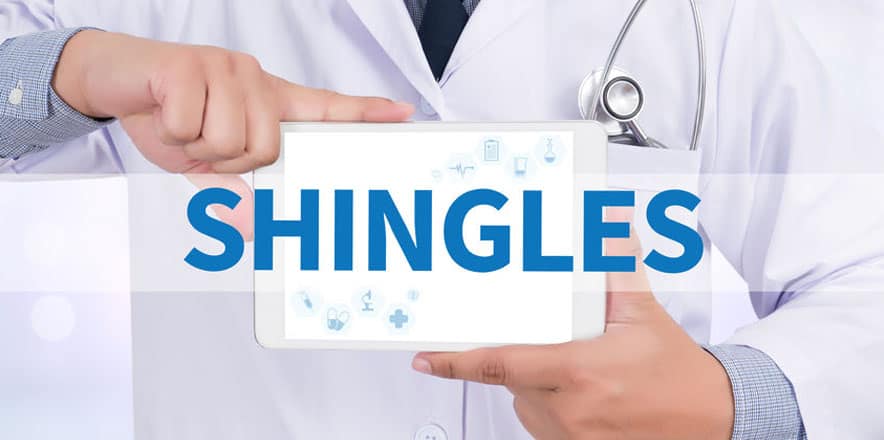The following is an excerpt from the American Academy of Dermatology, AAD.org. I think this is an important and timely subject.
[vc_empty_space height=”8px”]
Shingles: Overview
Also called herpes zoster
Anyone who has had chickenpox can get shingles. After the chickenpox clears, the virus stays in the body. If the virus reactivates (wakes up), the result is shingles — a painful, blistering rash.
Shingles is most common in older adults. A vaccine, which can prevent shingles, is available to people ages 50 and older. Dermatologists recommend this vaccine for everyone 50 and older.
If you get shingles, an anti-viral medicine can make symptoms milder and shorter. The medicine may even prevent long-lasting nerve pain. Anti-viral medicine is most effective when started within 3 days of seeing the rash.
[vc_empty_space height=”8px”]
Shingles: Signs and symptoms
Shingles tends to cause more pain and less itching than chickenpox. Common signs (what you see) and symptoms (what you feel) are:
The warning: An area of skin may burn, itch, tingle, or feel very sensitive. This usually occurs in a small area on 1 side of the body. These symptoms can come and go or be constant. Most people experience this for 1 to 3 days. It can last longer.
Rash: A rash then appears in the same area.
Blisters: The rash soon turns into groups of clear blisters. The blisters turn yellow or bloody before they crust over (scab) and heal. The blisters tend to last 2 to 3 weeks.
Pain: It is uncommon to have blisters without pain. Often the pain is bad enough for a doctor to prescribe painkillers. Once the blisters heal, the pain tends to lessen. The pain can last for months after the blisters clear.
Flu-like symptoms: The person may get a fever or headache with the rash.
Patches of skin can become very painful before the shingles appear.
[vc_empty_space height=”12px”]
[vc_row css=”.vc_custom_1474159960405{margin-bottom: -30px !important;padding-bottom: -30px !important;}”][vc_column width=”1/3″][vc_single_image image=”2074″ img_size=”400x 400″ alignment=”center” style=”vc_box_border_circle_2″][/vc_column][vc_column width=”1/3″][vc_single_image image=”2072″ img_size=”400x 400″ alignment=”center” style=”vc_box_border_circle_2″][/vc_column][vc_column width=”1/3″][vc_single_image image=”2073″ img_size=”400x 400″ alignment=”center” style=”vc_box_border_circle_2″][/vc_column][/vc_row]
Shingles: Who gets it and causes
A person must have had chickenpox to get shingles. Some people who have had chickenpox have a higher risk of getting shingles. These people:
- Are 50 years of age or older.
- Have an illness or injury.
- Are under great stress.
- Have a weakened immune system.
Some illnesses and medical treatments can weaken a person’s immune system and increase the risk. These include:
- Cancer.
- HIV/AIDS.
- Some cancer treatments, such as chemotherapy or radiation.
- Medicine taken to prevent rejection of a transplanted organ.
- Cortisone when taken for a long time.
[vc_empty_space height=”8px”]
What causes shingles?
The virus that causes chickenpox also causes shingles. After a person gets rid of the chickenpox, the virus stays in the body. The virus travels to the nerves where it sleeps. Shingles appears when the virus wakes up. It is not clear what reactivates or “wakes up” the virus. A short-term weakness in immunity may cause this.
Shingles is much less contagious than chickenpox. But a person with shingles can still spread the virus. Anyone who has not had chickenpox can get this virus.
If the virus spreads to someone who has not had it, the person will get chickenpox — not shingles. Newborns and those with a weak immune system have the highest risk of getting the virus from someone who has shingles.
This virus spreads when the person has uncovered, open blisters and someone touches the blisters. Once the blisters form scabs, the person is no longer contagious.
[vc_empty_space height=”8px”]
The Diagnosis and Shingles Treatment
[vc_empty_space height=”8px”]
How do dermatologists diagnose shingles?
To diagnose shingles, a dermatologist will look at the skin and ask some questions.
If there is any doubt, the dermatologist may scrape a blister to get a sample. This sample will be examined under a microscope. Also, the dermatologist may send the fluid from a blister to a laboratory for testing.
[vc_empty_space height=”8px”]
How do dermatologists treat shingles?
Without treatment, the rash clears in a few weeks. Dermatologists, however, strongly recommend shingles treatment. Without it, many people get pain, numbness, itching, and tingling that can last for months — or years.
It is best to get treatment immediately. Shingles treatment can include:
- Pain relievers to help ease the pain: The pain can be very bad, and prescription painkillers may be necessary.
- Anti-viral medicine: This medicine may be prescribed when a doctor diagnoses shingles within 72 hours of the rash first appearing. The earlier anti-viral treatment is started, the better it works. Anti-viral medicines include famciclovir, valacyclovir, and acyclovir. These can lessen the pain and the amount of time the pain lasts.
- Nerve blocks: Given for intense pain, these injections (shots) contain a numbing anesthetic and sometimes a corticosteroid.
- Corticosteroids: To lower swelling and pain, some patients may get corticosteroid pills with their anti-viral medicine. This treatment is not common because it can make the rash spread.
Treatments for pain after the rash clears: Certain anti-depressants, pain relievers, anesthetic creams and patches, and anti-seizure medicines can help.
Ask your dermatologist about possible side effects (health problems that can result from the medicines).
[vc_empty_space height=”8px”]
Outcome
Patients with shingles rarely need a hospital stay. But shingles can cause serious problems such as:
Post-herpetic neuralgia (post-her-PET-ic noo-RAL-jah):
This is the most common problem. It can cause pain, numbness, itching, and tingling. It can last for months — or even years. People who get this also may have fatigue, little appetite, and trouble sleeping. Sometimes they experience intense pain from something as harmless as a light touch. People over age 60 are most likely to have this complication.
Eye problems: Shingles that involve the eye are called ocular shingles or herpes zoster ophthalmicus. Signs and symptoms of shingles in the eye are blisters around the eye or on the eyelid, swelling and redness of the eye or eyelid, and eye pain. Some people become sensitive to light. After a bout with shingles that involves the eye, a person can have blurred vision or feel that something is in the eye.
If blisters appear on the tip of the nose, it may be a warning of possible eye problems. Anyone who gets blisters on the nose should see a doctor immediately. Without treatment, permanent eye damage can result. Glaucoma, scarring, and even blindness are possible. People who have shingles in the eye also may have a higher risk for having a stroke.
Bacterial infection: The blisters can become infected, which can slow healing. Lasting pain and redness warn of an infection. If either occurs, see your dermatologist. You may need antibiotic treatment. An infection can lead to scars without prompt treatment.



